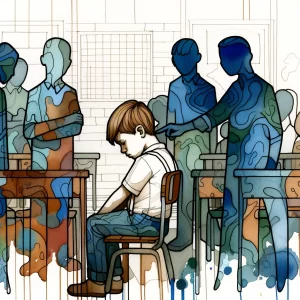
The Surprising Link Between Autism and Accents
“Why does my child sound… different?” It’s a question many parents of autistic children ask. Some notice their child speaks with an unusual accent—one that doesn’t match their family, their school, or even their country. It’s not just an isolated experience; research now shows that autistic children’s speech patterns often diverge from those of their peers and caregivers. But why?
A groundbreaking study from Italy sheds new light on this phenomenon, revealing that autistic children are more likely to adopt speech patterns influenced by screen media—cartoons, YouTube videos, and TV shows—rather than the regional dialects spoken in their homes and communities. This has profound implications for how autistic children acquire language, how others perceive them, and how we can better support their communication needs in school and at home.
What the Research Says: Cartoons, Not Caregivers, Shape Speech
Researchers conducted perception studies using audio recordings of autistic and typically developing children from Italy’s Campania region. This region has a distinct Italian dialect, making it an ideal setting to explore whether autistic children adopt the local speech patterns.
The findings were astonishing:
- Autistic children’s accents lacked the regional features of their community’s dialect.
- Their speech more closely resembled the standardized Italian heard in cartoons and children’s television shows.
- Non-autistic listeners identified autistic children’s accents as different, often mistaking them for more neutral or “standard” Italian, commonly used in the country’s northern regions.
This suggests that, unlike typically developing children who pick up language from social interactions, autistic children may rely more heavily on media as a primary language source. This is likely due to differences in how autistic children engage with their surroundings, process speech, and develop communication skills.
Why It Matters: The Social Impact of Speech Atypicality
Language isn’t just about words—it’s a social passport. How a child speaks influences how they are perceived, how they integrate into peer groups, and how confident they feel in school settings. If an autistic child’s speech doesn’t match the local dialect or carries an unusual intonation, they might face social challenges:
- Being perceived as “different” or “foreign” by peers and teachers.
- Struggling with peer acceptance due to the social weight accents carry.
- Receiving unfair judgments about intelligence or personality, as people often associate accents with certain stereotypes.
This can have serious implications for autistic children’s social development and self-esteem. It also highlights the urgent need for schools and caregivers to foster understanding and inclusivity around speech differences.
The Bigger Picture: What This Means for Schools and Parents
Understanding that autistic children may acquire speech differently opens doors for better support strategies. Here’s how educators, speech therapists, and parents can use these insights:
1. Rethink Speech Therapy Approaches
Many speech therapy models assume children learn language best through interactive conversations. But for autistic children, passive learning from media may play a bigger role. Therapists might consider incorporating more structured media-based language learning, followed by guided social interaction to bridge the gap between screen-based learning and real-world communication.
2. Encourage Speech Diversity in Schools
Teachers and school psychologists should be aware that speech atypicality in autistic children is not necessarily a deficit—it’s a different developmental pathway. Training programs should help educators recognize and respect speech differences rather than view them as something to “correct.”
3. Promote Peer Awareness and Inclusion
Classroom discussions about dialects, language development, and neurodiversity can help students become more accepting of speech differences. Schools should actively work to prevent bullying or exclusion based on the way children speak.
4. Support Parents in Understanding Their Child’s Speech Development
Parents of autistic children often worry if their child’s speech patterns don’t match those of their family. Understanding the role of media in language development can help parents feel less concerned and more equipped to support their child’s communication journey.
What’s Next? The Need for More Research and Advocacy
This study raises bigger questions: Should language development interventions for autistic children include structured media exposure? How do different languages and dialects shape autistic speech patterns globally? And most importantly, how can we shift public perceptions so that atypical accents aren’t seen as “wrong” but simply as part of neurodiversity?
Let’s Talk About It!
This research challenges many assumptions about how children learn to speak. Now, we want to hear from you:
- Have you noticed speech differences in autistic children you know?
- How do schools currently handle speech diversity, and what could be improved?
- What role do you think screen media should play in language development for autistic kids?
Share your thoughts in the comments, spread awareness by sharing this blog, and let’s start a conversation about how we can better support neurodivergent children in their unique communication journeys.
Step into the Future of School Psychology!
Engage with the dynamic field of educational mental health for only $5 monthly. This Week in School Psychology offers you a gateway to understanding and applying crucial psychological findings. Enjoy concise, powerful updates that make a difference. Subscribe and join a community dedicated to knowledge and impact. Take advantage of our special yearly rate and lead the way in educational innovation!



